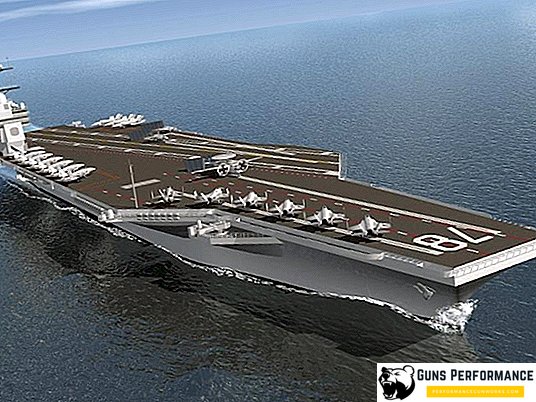The Soviet Union is considered to be the country-ancestor of a class of warships like rocket boats. Developed in the depths of the Supreme Naval Command, the naval concept of fleet development provided for equipping the fleet with small combat vessels that were comparable in power to ships of the far sea zone. Creating a "mosquito fleet" allowed in a short time and at fairly low costs to create effective means of defense of the maritime frontiers. High speed, low visibility and powerful rocket weapons made such ships truly dangerous opponents for any warship.

The appearance of missile boats at sea disrupted the advantages of a large ocean fleet in the coastal sea zone. Subsequent historical events have shown the correctness of the developed concept. Created by Soviet designers, missile boats became a "revolutionary breakthrough" in the history of world military shipbuilding. Despite the low displacement, due to the high speed and powerful armament, ships of this class in the Western classification were ranked as corvettes. One of the best representatives of ships of this class is rightly considered to be rocket boats of the 1241 type, built at domestic shipyards for 17 years.
Background to the emergence of boats project 1241
It should be noted that the idea of creating a "mosquito fleet" is not new. Even on the eve of the First World War, some European countries sought to strengthen their own naval forces through the construction of small high-speed combat ships. Then the main armament of ships of this class was a mine weapon. The successful use of torpedo boats by Italian sailors during a naval war against a stronger enemy showed the great potential of the small fleet. From the category of the fleet for the poor, the "mosquito fleet" has moved into the category of the most effective instruments of warfare in the coastal marine zone.

After the end of the Second World War, they began to develop the same idea in the Soviet Union. If modern fleets have learned how to effectively deal with torpedo and mine weapons, the appearance of missiles has opened new horizons for waging war at sea. Ships with a small displacement, with a high speed and armed with anti-ship missiles could become a reliable shield in the defense of ports and fleet-based locations. Particularly attractive was the opportunity to install combat missiles on a mobile platform with high speed.
The first swallow was a rocket boat of the "Komar" type, which was actively built at Soviet shipyards for 3 years, from 1959 to 1961. In such a short period, up to 100 warships were launched, each of which carried two cruise SS-N-2A Styx anti-ship missiles.
These warships were the first to demonstrate their effectiveness in practice. During the 1967 Six-Day Arab-Israeli War, an Egyptian Komar-type missile boat was able to sink the Israeli destroyer Eilat. This was the reason for the intensive and massive construction of ships of this class all over the world. Special attention was paid to the third world countries, which could not afford to build or maintain large military fleets.
The Soviet Union in this arms race was considered the clear favorite. By the time the USSR Navy was armed with a sufficiently large number of missile boats of various types. There was a development of new, more powerful vessels capable of performing a wider range of tactical tasks. The pinnacle of design ideas was the project 1241 - a new rocket boat of the "Tarantula" type.
Birth of the missile boat of the new project 1241

The combat use of missile boats clearly showed how effective this type of naval weaponry could be. Rocket weapons, which became the main type of weapons in the fleet over time, radically changed the tactics of naval combat. In modern combat conditions, direct contact between the opposing sides was meaningless. The blows could be inflicted not only unexpectedly and at great distances, but also with much smaller forces. A large warship became vulnerable at sea in front of the weakest adversary. Almost rocket boats equalized the chances of the navy, shaking the principles of mastering the maritime theater through large formations of warships.
Project 1241 missile boat is the most modern type of ships of this class, which continues to be in service in the Russian Navy. Despite the fact that the first ship was launched in 1978, more than 40 years ago, the effectiveness of this type of naval armament remains high. Representatives of the US Navy, who were able to test the tactical and technical characteristics of the vessel in practice, spoke flatteringly about the high combat capabilities of the Soviet ship.
To the note: The boat "Rudolf Egelhofer" of the "Tarantula" type, which is part of the East German Navy, after the unification of the country, became part of the German Navy. The vessel received a new name and was soon transferred to overseas allies for careful study.
The lead ship of this project was launched in Leningrad in 1978. The place of construction of the boat was the shipbuilding plant them. Petrovsky, now Primorsky Shipyard. The new large rocket boat received the Tarantula cipher and was classified in the western countries as a corvette.
Design documentation for the warship was developed by the designers of the Central Marine Design Bureau "Almaz" - the fiefdoms of Soviet missile boats and ships of other main classes. Initially, the technical assignment for the creation of a more sophisticated ship was received in 1973. The design documentation for the new rocket boat with four anti-ship missiles was ready for 2 years, but the project had to be postponed for a while. The delay in the construction of ships was associated with the ongoing work on the creation of a new anti-ship complex "Moskit", which was planned to arm the new ships.
In comparison with the previous ships of this class, the new ship should have a greater displacement, better seaworthy characteristics and increased autonomy. The 3M80 anti-ship missiles in service with the navy had considerable dimensions and weight, so it was necessary to create a highly mobile platform of greater displacement. The benchmark steel was 400-500 tons, in which the new powerful propulsion system was supposed to fit, more advanced radar equipment and four 3M80 anti-ship missiles.
With new small ships it was planned to equip the Black Sea and Baltic fleets, which needed to have a reliable and powerful strike force in a limited maritime theater. In parallel, developed and export version. The main customers for the new ship were the Arab countries, the Navy of Vietnam, Cuba and the countries of the Warsaw Pact organization.
The purpose of the Project 1241 ships is to launch a missile strike against the ships of a potential enemy in the near-sea zone. Due to the high speed of the rocket boats could quickly go to intercept the enemy ship, launch missiles and go at high speed from under retaliation.

Behind the lead ship was begun mass production of ships. For the needs of the Soviet Navy was built 13 boats of this project. For export were delivered 20 ships of this type. In the Navy of Vietnam, Soviet missile boats constituted the main strike power of the fleet. The rocket boats of the fleets of the Warsaw Pact countries, the Egyptian fleet, the Yemeni Navy, India and Turkmenistan filled up the Tarantula missile boats. In total, up to 80 rocket boats of all modifications were launched, the base for which was the 1241 project.
Features of boats of the project 1241
Both projects, both domestic and export, provided ample opportunities for the subsequent improvement of vessels in the framework of ongoing re-equipment and re-equipment. Boats were supposed to have a displacement of no more than 500 tons and carry powerful offensive and defensive weapons. The main combat weapon for the boats were the PKR P-270 Mosquito, which were located in two containers, two on each side. Rocket containers were not guided, but fixed permanently with a constant angle of elevation and at an angle in the center plane relative to the vessel’s axis.
The anti-aircraft armament of the ship was presented by the Osa-M or Strela-3 missile systems. Additionally, the crew of the vessel was equipped with Igla MANPADS. The traditional offensive and defensive armament was the AU-176 76 mm caliber artillery, which could fire on both naval targets and ground and air targets. The 30-mm AK-630M artillery mounts, mounted on the stern, also reinforced the combat power of the boat.
Artillery installation has a total weight of up to 9 tons. The gun could fire in automatic mode at a distance of 4000 m.

Combat control and aiming weapons at the target was carried out by the multi-functional radar station "Pearl". The system was half automated, which allowed the crew to directly participate in the management of the combat capabilities of the vessel. Despite the fact that the new radar had unique characteristics, its creation was delayed and therefore launch boats were equipped with the Monolith radar.
A distinctive feature of rocket boats is a cylindrical cap, located above the wheelhouse. It houses the antenna of the active channel of the radar complex. On the boats of the following series they began to install installations for launching false targets and projectiles with radar reflectors. These activities were carried out in the framework of electronic warfare, which in recent years has acquired an intense nature at sea. Installations PC-16 were placed on the sides of the vessel and could fire with projectiles equipped with dipole reflectors.
The radial stations "Gravel-M" were placed on the boats of export construction. In this regard, the Osa-M SAM system was removed on the boats, and an AK-630M additional gun mount was installed.
The performance characteristics of the new Soviet missile boats were impressive. In terms of its combat and fire characteristics, the Tarantula looked more like a corvette. The boat could reach a speed of 36 knots on a combat course, and the cruising range in an economical course was almost 1,500 miles. In the later versions, which today stand on the equipment of the Russian fleet, the cruising range is more than 2000 nautical miles.
However, project data is one thing, but the real picture is another. As in the case of the Zhemchug radar, the development and mastering of the industrial production of the Moskit anti-ship missiles was very late. It was decided to install on the boats proven anti-ship missiles P-15 "Termit", and on vessels under export contracts - PRK P-20.
Note: The Soviet P-15M Termite rocket had a starting mass of 2.5 tons and was equipped with a warhead weighing up to 400 kg. The rocket flew at a height of 20-50 meters at sea level, developing a speed of 320 m / s.

The power plant on boats of both versions was presented to four M-75 main engines with a total capacity of 10,000 hp. and two M-70 engines, providing the movement of the vessel at high speeds. The afterburner power was 24,000 hp. With enormous power and high efficiency, the propulsion system on rocket boats of the project 1241 had a number of drawbacks. During mooring evolution and at low speeds, the control of the propulsion system caused criticism from the sailors.
Finally, the good seaworthiness of the new vessels should be noted. The steel hull of the boat, divided into 9 watertight compartments, has a sheer configuration and fast lines. With a hull length of 56 meters, the depth of the boat on the amidship was 5.31 m, which made the small ship resistant to sea excitement of 7-8 points. Superstructures of the vessel are made of lightweight metal alloys, which significantly affected the observance of restrictions on displacement.
In such conditions, the crew of the vessel consisted of 41 people, and the autonomy of the vessel’s navigation was 10 days.
History of the construction of boats project 1241
The head company for the construction of rocket boats of the project 1241 was chosen for the Primorsky Shipbuilding Plant, which is native to Almaz Central Marine Design Bureau. On the stocks of this shipyard all the boats of the first two modifications were built. In the future, the construction of boats of the project of other modifications was conducted at once in three shipyards, at two plants in Leningrad and at one plant in the Khabarovsk Territory.
Project 1241 was the most popular for ships of this class. For 12 years, for the Navy of the USSR 41 ships were built, relating to various modifications. By the time of the collapse of the Soviet Union in 1991, there were 6 more rocket boats of this type on the stocks, their readiness was evaluated differently, from 30 to 90%. The last ship of this project is to be launched in 1996.
In recent versions, a number of corrections have been made regarding the ship’s weapons. Instead of a 30-mm weapon, the Kortik anti-aircraft missile system was installed on the boats. Also, boats received a radar target detection "Positive".

It should be noted that shipyards in Rybinsk and Yaroslavl were engaged in the export option. Under foreign contracts for the Naval Forces of the Warsaw Pact Organization, 14 Tarantula-type missile boats were built. Most of all ordered the GDR and Poland, which respectively purchased 5 and 4 ships. Four ships ordered India for its Navy. One boat was built for the Navy of Yemen and Vietnam. One rocket boat of the export project was transferred to the Baltic Fleet Training Center, located in Riga. The vessel was used as a training platform for training foreign crews.
The increased interest in the ships of this project from India is confirmed by the purchase of a license for the subsequent construction of ships of this class at the shipyards in Mumbai and Goa.
For reference: In the navy of Romania, Poland, and India in the Ukrainian Navy, boats of project 1241 are assigned to the class of corvettes.
In the domestic Russian fleet, 5 vessels of the very first project remain in service today. On the Black Sea in the ranks remains a missile boat P-71 "Shuya". The structure of the Baltic fleet includes ships R-129 "Kuznetsk" and R-257. Until recently, the R-101 missile boat was transferred from the Northern Fleet to the Caspian Sea, where it became part of the Caspian military flotilla. One missile boat U155 Dnieper "is part of the Ukrainian Navy.
The ships of the later series, the improved modifications continue to remain in the ranks, representing the strike link of the Pacific Fleet, acting as part of the strike formations of missile cruisers as part of the Black Sea and Baltic fleets. The most numerous detachment (10 combat units) of missile ships of this class is in the Far East. Five ships each were located on the Black Sea maritime theater and in the Baltic. From the Black Sea Fleet, one R-160 missile boat was transferred to the Caspian Military Flotilla.
Needless to say, the role played by project 1241 missile boats, carrying many years of service as part of the Soviet Navy and the modern Russian navy. The construction of one ship of this class was simply incommensurable in cost and cost with the construction of large ocean-going ships armed with rocket weapons. Thanks to rocket boats, the Soviet and, first, the Russian fleet were able to create an efficient group of strike ships on their flanks.












